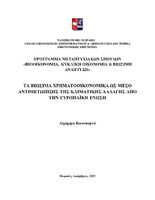Τα βιώσιμα χρηματοοικονομικά ως μέσο αντιμετώπισης της κλιματικής αλλαγής από την Ευρωπαϊκή Ένωση
Sustanable finance as a means of the European Union for tackling climate change

View/
Keywords
Βιώσιμα χρηματοοικονομικά ; Ευρωπαϊκή Ένωση ; EU taxonomy ; EU Green Bond Standard ; Next Generation EU ; Green Deal ; Invest EU ; Αειφόρες επενδύσεις ; Δείκτες ESG ; Benchmarks ; NFRD ; SFDR ; Πράσινος Υποστηρικτικός Παράγοντας ; Κλιματική αλλαγή ; Κλιματικοί πρόσφυγες ; Κίνδυνοι κλιματικής αλλαγήςAbstract
While climate change affects- among other things- business activity, the European Commission adopted a green agenda, which led to the setting up of the Renewed Sustainable Finance Strategy. Its purpose is the formation of an orderly economy that achieves social and environmental goals, as its activities can be divided into three categories: Reorienting capital flows towards a more sustainable economy, mainstreaming sustainability into risk management and fostering transparency and long-termism. The most comprehensive tool available to the European Union for the implementation of the Strategy is the EU Taxonomy, which, however, due to its early stage, is characterized by weaknesses presented at the end of the first chapter. Subsequently, the relationship between companies and green investments is examined based on data from the European Investment Bank and then, an attempt is made to correlate the level of green investments with ESG indicators. Specifically, the first three and the last three countries in green investments are selected according to the ranking of the European Investment Bank reports, and with the help of a linear regression their relationship with economic, social and environmental indicators is examined. The final chapter draws conclusions about the regression effect, which are supported by the international literature, and assesses whether the Sustainable Finance Action Plan responds to the need to address the risks arising from climate change.

